Related Research Articles

The French and Indian War (1754–1763) was a theater of the Seven Years' War, which pitted the North American colonies of the British Empire against those of the French, each side being supported by various Native American tribes. At the start of the war, the French colonies had a population of roughly 60,000 settlers, compared with 2 million in the British colonies. The outnumbered French particularly depended on their native allies.
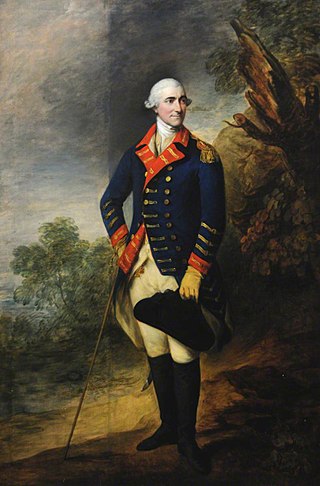
Field Marshal Henry Seymour Conway was a British general and statesman. A brother of the 1st Marquess of Hertford, and cousin of Horace Walpole, he began his military career in the War of the Austrian Succession. He held various political offices including Chief Secretary for Ireland, Secretary of State for the Southern Department, Leader of the House of Commons and Secretary of State for the Northern Department. He eventually rose to the position of Commander-in-Chief of the Forces.

Events from the year 1757 in Canada.
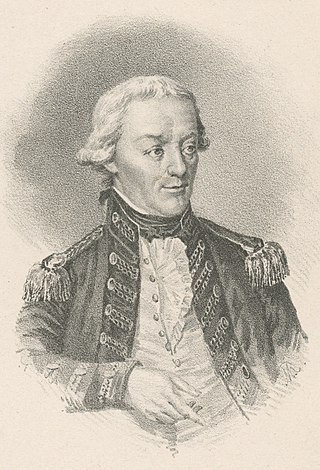
Lieutenant General Richard Prescott (1725–1788) was a British officer born in England.
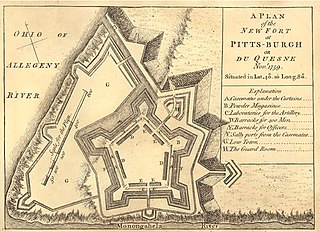
Fort Pitt was a fort built by British forces between 1759 and 1761 during the French and Indian War at the confluence of the Monongahela and Allegheny rivers, where the Ohio River is formed in western Pennsylvania. It was near the site of Fort Duquesne, a French colonial fort built in 1754 as tensions increased between Great Britain and France in both Europe and North America. The French destroyed Fort Duquesne in 1758 when they retreated under British attack.

The 55th Regiment of Foot was a British Army infantry regiment, raised in 1755. After 1782 it had a county designation added, becoming known as the 55th (Westmorland) Regiment of Foot. Under the Childers Reforms it amalgamated with the 34th (Cumberland) Regiment of Foot to form the Border Regiment in 1881.
The 74th Regiment of Foot was an infantry regiment of the British Army from 1758 to 1763.

Fort Pitt Museum is an indoor/outdoor museum that is administered by the Senator John Heinz History Center in downtown Pittsburgh, Allegheny County, Pennsylvania in the United States. It is at the confluence of the Monongahela and Allegheny Rivers, where the Ohio River is formed. Fort Pitt Museum is surrounded by Point State Park, a Pennsylvania state park named for the geographically and historically significant point that is between the rivers. This piece of land was key to controlling the upper reaches of the Ohio River Valley and western Pennsylvania, before, during and after the French and Indian War as well as the American Revolution.
Thomas Cumming was an American merchant of the 18th century who built up a large commercial empire in West Africa. He is best known for the role he played in the 1758 Capture of Senegal in which he submitted a plan to the British war leader William Pitt which advocated an attack on France's valuable but ill-defended African colonies.

The siege of Louisbourg was a pivotal operation of the French and Indian War in 1758 that ended French colonial dominance in Atlantic Canada and led to the subsequent British campaign to capture Quebec in 1759 and the remainder of New France the following year.
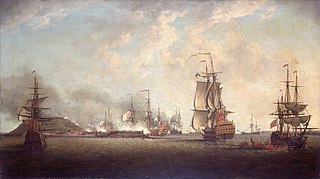
HMS Nassau was a 70-gun third rate ship of the line of the Royal Navy, built at Portsmouth Dockyard and launched on 9 January 1706.

HMS Harwich was a 50-gun fourth rate ship of the line of the Royal Navy, built at King's Yard in Harwich by John Barnard to the dimensions laid down in the 1741 proposals of the 1719 Establishment at Harwich, and launched on 22 December 1743.

HMS York was a 60-gun fourth rate ship of the line of the Royal Navy, built at Plymouth Dockyard to the draught specified in the 1745 Establishment, and launched on 10 November 1753. She saw active service during the Seven Years' War against France, and was responsible for the capture of seven French vessels over her ten years at sea. After extensive service in Europe, North America and the east Indies, York was decommissioned in 1765 and broken up at Plymouth in 1772.
HMS Burford was a 70-gun third rate ship of the line of the Royal Navy, built at Chatham Dockyard to the draught specified by the 1745 Establishment as amended in 1754, and launched in 1757.

The Seven Years' War (1756–1763) was a global conflict involving most of the European great powers, fought primarily in Europe and the Americas. One of the opposing alliances was led by Great Britain and Prussia. The other alliance was led by France, backed by Spain, Saxony, Sweden, and Russia. Related conflicts include the 1754 to 1763 French and Indian War, and 1762 to 1763 Anglo-Spanish War.

The Raid on Cherbourg took place in August 1758 during the Seven Years' War when a British force was landed on the coast of France by the Royal Navy with the intention of attacking the town of Cherbourg as part of the British government's policy of "descents" on the French coasts.
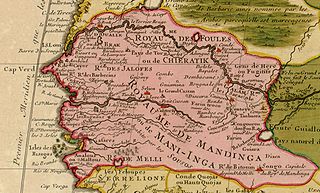
The British capture of Senegal took place in 1758 during the Seven Years' War with France, as part of a concerted British strategy to weaken the French economy by damaging her international trade. To this end, a succession of small British military expeditions landed in Senegal and captured Gorée and Fort Saint Louis, the French slave fort located at Saint-Louis, seizing French vessels and supplies. By late 1758 the whole of the French colony on the Senegalese coast had been captured by the British, with administrative matters being handled by the first British Governor of Senegal, Lieutenant Colonel Richard Worge.

The Capture of Gorée occurred in December 1758 when a British naval expedition led by Augustus Keppel against the French island of Gorée off the coast of Senegal during the Seven Years' War. Keppel bombarded the fortress and then landed his marines to take possession. The French commander, Blaise Estoupan de Saint-Jean surrendered the fortress and the island. The 300-man garrison became prisoners of war, and 110 guns and mortars were captured.
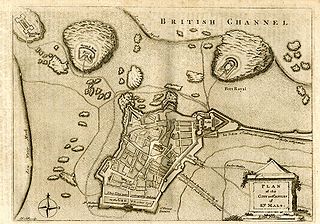
The Raid on St Malo took place in June 1758 when an amphibious British naval expedition landed close to the French port of St Malo in Brittany. While the town itself was not attacked, as had been initially planned, the British destroyed large amounts of shipping before re-embarking a week later. The naval forces were under the command of Richard Howe while the army was led by the Duke of Marlborough and Lord Sackville.
William Rufane was a British soldier who fought in the Seven Years' War, was governor of Martinique in 1762–63 and rose to the rank of lieutenant general.
References
- ↑ "Henry Marsh (d.1772)". threedecks.org. Cy Harrison. Retrieved 20 August 2021.
- ↑ "1758 - British expedition against Fort Louis in Senegal - Project Seven Years War". www.kronoskaf.com. Project Seven Years War. Retrieved 20 August 2021.